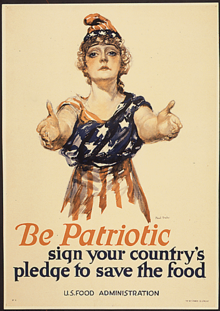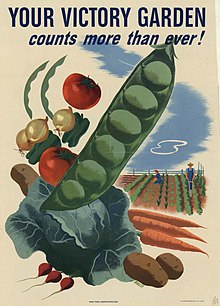United States Food Administration
The United States Food Administration was after the entry of the United States into the First World War for the time of its continuation an authority with the task of managing food. An important goal was the stabilization of agricultural producer prices.
Origin of the name
In May 1917, the United States entered the First World War, President Woodrow Wilson saw Herbert Hoover , who had just gained relevant experience with the Belgian relief organization , as suitable to farm the food for the war. On May 9, 1917, he was entrusted with the food administration under the Lever Act and Executive Order 2679-A of August 10, 1917. In response to the bad harvests of 1916 and 1917, Wilson envisioned the establishment of a food management office, but Hoover was able to talk him out of the idea, bearing in mind the unpopularity of such offices in Europe. He wanted to see the decision-making authority in a single person, in every phase "from the field to the stomach". Wilson, in turn, wanted to avoid anything that could have given the impression of a “food dictator”. The problem was solved by choosing the designation “administrator” for Hoover and “administration” for the management, which provided the image of mutual coordination with tight leadership at the same time. In contrast to all other undertakings caused by the war, the food administration was the only one that was not subordinate to an office or a commission and for months “knew no tinsel and no splendor of uniform”.
Decisive food

The entry of the USA into the war was welcomed by Great Britain less because of the support it provided on the battlefield than because of the relief of the tense food situation. After the declaration of unrestricted submarine warfare by the Germans, the relief efforts for the British, 80 percent of whom depended on overseas transport for their bread, had to ceaselessly take into account the realization that food would win the war. The "Food and Fuel Control Act" of August 10, 1917 gave Hoover the powers he wanted, which enabled him to raise the necessary amounts of food with a mixture of coercion and appeal to voluntarily renounce. An advisory committee was created for consumers and a war committee for farmers, who should not be called up for military service if possible. In order to stabilize a low price level, no flat-rate maximum prices were prescribed, but surcharges were set for each processing stage. The prevention of speculation and guaranteeing promised producer prices was consequently also one of the main tasks of the US Grain Corporation founded by USFA and the US Sugar Equalization Board , of which the state was the sole shareholder. In all of this, care was taken not to allow bureaucracy to arise from those who are not familiar with the matter, but to ask the industries themselves to be accountable. Unusual was the opportunity to become a “member” of the food administration through a commitment to simple living - 20 million citizens took the step. After completing $ 7 billion in transactions, the agency became obsolete with the end of the war. President Wilson asked Herbert Hoover on November 7, 1918, to transfer them to a new company whose purpose would be food aid and reconstruction in Europe. The legal basis for this " American Relief Administration " was created on February 25, 1919.
Public campaigns
A meatless Meatless Monday was introduced in the United States as early as World War I. The USFA appealed to families and especially housewives to forego certain foods (meat on Mondays, wheat on Wednesdays) for the war effort. The USFA offered a variety of promotional materials for the promotion, including recipe suggestions and health recommendations. The campaign was repeated during World War II and it was also recommended and supported to grow and eat more vegetables yourself.
For this purpose, the so-called Victory Gardens were propagated and laid out nationwide, the typical format of vegetable gardens in urban areas and parks has been resumed since 2000 under different conditions. The "kitchen garden" laid out in March 2009 by First Lady Michelle Obama on the lawn of the White House, the first such kitchen garden since 1945 Eleanor Roosevelt had left the White House, became famous.
proof
- Herbert Hoover: Memoirs (Vol. 1). Years of Adventure 1874–1920 , Matthias Grünewald Verlag, Mainz 1951, pp. 215–225
- Herbert Hoover: Memoirs (Vol. 2). The Cabinet and the Presidency 1920–1933 , Matthias-Grünewald-Verlag, Mainz 1952, pp. 20–28
literature
- Frank M. Surface / Raymond L. Bland: American Food in the World War and Reconstruction Period. Operations of the Organizations Under the Direction of Herbert Hoover 1914 to 1924 , Stanford University Press, Stanford 1931
Web links
Individual evidence
- ↑ http://www.archives.gov/education/lessons/sow-seeds/
- ^ Herbert Hoover: Memoirs (Vol. 1) , Mainz 1951, p. 234
- ^ Frank M. Surface / Raymond L. Bland: American Food in the World War and Reconstruction Period , Stanford 1931, p. 266
- ^ Bertrand M. Patenaude : The Big Show in Bololand, Stanford 2002, p. 29
- ↑ Wheatless Wednesdays . Hoover Museum - Digital Archives. Archived from the original on September 11, 2013. Info: The archive link was inserted automatically and has not yet been checked. Please check the original and archive link according to the instructions and then remove this notice. Retrieved October 22, 2013.
- ↑ http://exhibits.mannlib.cornell.edu/meatlesswheatless/images/large/Foods%20That%20Will%20Win%20115.jpg
- ^ World War II Rationing . Us-history.com. Retrieved October 22, 2013.
- ^ Marian Burros: Obamas to Plant Vegetable Garden at White House , The New York Times, March 19, 2009


